Today at Jimmy’s 7-17-17
Found on Chester Dam Road: Soft case loaded with reel, spools, and lines.
Call Andy: 207-713-3457. Give correct description of contents to claim.
Found on Chester Dam Road: Soft case loaded with reel, spools, and lines.
Call Andy: 207-713-3457. Give correct description of contents to claim.
Great news for the South Fork! We are at normal irrigation demand flows (currently 11900 cfs out of Palisades Dam, 14500 cfs at Heise) which may prevail for weeks, and the river is shaping up in a fly fishing sense. Established riffle areas have become riffles again, soft water is increasing in size & amount, and drop-offs are more easily approached. There are some physical changes in the river meaning new channels, movement of gravel bars and some riffles, size of islands, etc. This is especially true for the lower river. Consider that the South Fork from Byington downstream is a “new river.” That means new channels, new riffles, new drop-offs, new snags and log jams. In other words new everything. Changes such as these are to be expected because of length of time that the unusually high flows (since March) took place. All this means caution takes a front seat when fishing especially this section of river.
With respect to fly-fishing strategy, nymphing with such as rubber legs on down in size to your favorite bead head patterns are the way to go for now. With respect to dry fly presentation, effectiveness will improve as we move through the days ahead. So try your favorite golden stonefly adult pattern trailed with a small bead head nymph dropper such as copper john, zebra, or prince. PMDs and sallys are coming out on the lower river, but it may take a few days for trout to key on them in a serious manner. Below see some fly pattern info that you can use to build a inventory for upcoming trips on the South Fork (and Henry’s Fork)

We at Jimmy’s will keep on top of the South Fork’s return to its reputation as a great fly-fishing location. Get in touch with us for up-to-date info on it, or on any other area stream or still water.
IDF&G is strongly considering a salvage regulation on the Big Lost River below Moore. This is because as flows out of Mackay Dam decrease fish will become trapped in downstream pools and perish. So rather than being wasted, salvage by legal means is being considered for the lower river. Go to the IDF&G web site for details on where this operation will be applied and for how long.
Action is slowing down somewhat. Best strategy will be to head for creek mouths. All creeks coming into the lake have good water levels this season. Cooler water coming from them attracts fish because of higher dissolved oxygen concentrations. The same applies to spring holes. Get to these locations early in the day to present your favorite leech and damselfly nymph patterns, but expect company from “anglers in the know” as the day advances. Want to experience even better still water fishing than Henry’s Lake currently offers? It’s not far from Henry’s Lake and can be found during the Madison Arm gulper activity on Hebgen Lake.
Run-off is leaving many of our smaller streams, but remnant conditions remain on some. Big Elk, Bitch, and Palisades Creeks area a little high and a bit discolored. The same for Teton River. Lower Palisades Creek could clear first because the lower lake acts as a settling basin. For now presenting nymph patterns and anything simulating an earthworm might be the best way to go in these creeks. McCoy and Bear Creeks, however, are in good dry fly shape. The same applies to the upper Blackfoot River, where even though hoppers are flourishing ( mosquitos are doing the same) throughout the meadows, the river is high enough where fish still key most on patterns resembling earthworms and grubs. Robinson Creek is now in great dry fly fishing shape as is Warm River. For PM fishing caddis life cycle and traditional attractor patterns may produce best on these two streams. Visitations are up on all these streams, but you can bet that when dry fly conditions kick in on the South Fork, many fly fishers will forsake these excellent smaller waters and tranquility will intensify.
With flow out of Palisades Dam reduced to 16000 cfs, look for riffles to begin appearing in the river below, even though flow at Heise is about 17 500 cfs. Those flows will soon drop. Now that run-off is nearly over expect further drops in flow out of Palisades Dam, even though there will be agricultural demands. Fish the soft water for now, but stock up on those patterns (PMD and caddis life cycle patterns terrestrial insect patterns, your favorite bead head nymph pattern, etc.) best for the great South Fork riffle and drop-off fishing soon to come.
Some Great Places to Introduce Neophytes to Fly Fishing
Certainly there are numerous locations in our area suitable for introducing a family member, young, middle-aged or senior person to fly-fishing. There, however, certain locations having attractions which make them choice candidates for this action. First and foremost, these locations are relatively safe when compared to large flowing waters. Then they are tranquil, meaning tending to be less crowded. And these locations offer superb chances for encountering feeding fish.
Definitely, these places cannot compare to the convenience of such as Ryder Park Pond, an excellent example of foresightedness on the part of Idaho Falls city administration and the Idaho Department of Fish and Game. But because of being near urban areas, these can become crowded during prime time.
We experienced fly-fishers tend to overlook an absolute when considering introducing a person to fly-fishing. That absolute is that big waters can be intimidating to the neophyte, let alone generally more perilous. Small waters reduce a location into “classroom size” thus offering a better chance of concentrating the entire fly-fishing experience of reading water, appropriate presentation, hooking, playing, landing, and releasing sport fish. All this comes about because salmonids tend to feed less selectively and more aggressively in small waters. Concentrating the beginning fly-fishing experience places the neophyte more quickly on the road to success on all waters.
To begin, let’s look at some streams that are great locations. For each of these a strategy applies. Resident trout tend to take wet flies until, around mid-day, when waters warm to the point that aquatic and terrestrial insects become active and thus available on the surface for feeding fish. As summer advances and waters warm, early and late in the day become the best times to fish but especially on still waters. Also, light weight tackle systems (ranging from 2-weight to four weight) are most appropriate for encountering these fish these waters.
Birch Creek

Add great scenery to the above mentioned small water aspects, and no stream is as good a candidate as Birch Creek. Just above Lone Pine and adjacent to State Highway 28, the Birch Creek Family Fishing Area is ideal. It features eager brook and rainbow trout. Both are wild and full of vigor. These tend to feed throughout the season, and will take any properly presented fly in small and medium sizes. Wet wading is a good choice for this easily approached stream, but no more than hip waders are necessary. This part of the creek is on private land, so practice due respect to fences and any structure or stock. A good way to express appreciation would be to carry out any trash encountered and to close open gates.
Upper Warm River
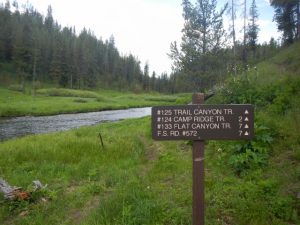
Upper Warm River is another good stream for introducing fly-fishing to an entry level person. Eager brook trout are the residents here, and all are endowed with the aggressive brook trout nature. Almost any small bead head nymph or peacock woolly worm presented using lightweight gear will bring responses from these small but aggressive brookies. The Pole Bridge campground makes a great base for enjoying fishing on this stream. It is not totally developed but serviceable. Access it by traveling the Mesa Falls Scenic Highway to the Warm River Road or the Hatchery Butte Road from the same highway. This is bear country, so particularly for overnight stays, follow proper procedures.
Sawmill Creek
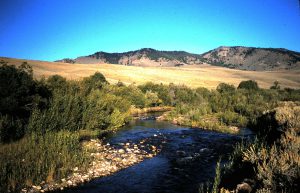
If you do not mind taking a one hundred and thirty mile drive, mostly across the desert then through the scenic Little Lost River Valley, Sawmill Creek is another great candidate for an entry level fly-fisher. From State Highway 33, follow the Little Lost River Road to the Sawmill Creek Road. There are no developed camping facilities here, but there are plenty of pull-outs from which fishing can be enjoyed. As with Birch Creek, wild brook and rainbow trout are the residents, and they are just as eager to take the same flies presented using light weight gear.
Some still waters make good locations for entry level fly-fishers. All of these feature the option of fishing from the shore or from a non-motorized boat or flotation device. Non-motorized means powered by an internal combustion engine.
Horseshoe Lake
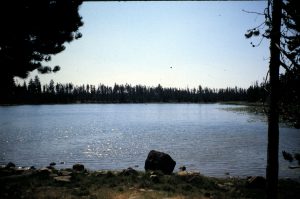
Horseshoe Lake Is a good example except that shoreline fishing takes a back seat to fishing from a flotation device or small boat. To get there, travel the Cave Falls Road off the Mesa Falls Scenic Highway. After entering the Caribou-Targhee National Forest (where pavement ends) travel about five miles to the Horseshoe Lake Road which heads northeast. About five miles later the lake comes in view on the right. Camping is primitive there, but relatively tranquil. The east arm of the lake is off limits to fishing, but the west end features lily pad banks in front of which is the best fishing. Grayling, supplemented by annual stockings, are the featured fish here. They are accompanied by rainbow trout, also stocked annually. When mayflies and damselflies are active these fish will feed on the surface and take any correctly sized imitation offered.
Jim Moore Pond

Jim Moore Pond (aka Roberts Gravel Pond) off the Osgood-Roberts Road (old Highway 91) is a good candidate. Stocked with rainbow and tiger trout (cross between brook and brown trout) , it offers a lengthy shoreline for bank fishing. These fish are supplemented each year by Idaho Department of Fish and Game (IDF&G) releases. Bank fishing here is ideal for fly-fishing because of ample room for back-casts. Best fly patterns are those simulating leeches, the main food form for trout. Small boats and flotation devices are easily launched and because of a small size this pond is not greatly impacted by winds.
Paul Reservoir
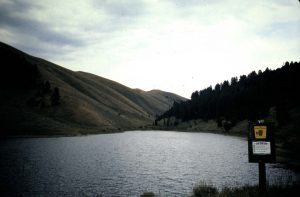
Paul Reservoir is another small still water ideal for teaching fly-fishing. The back side of the dam and the right-hand shore line offer great locations to cast from shore, and flotation devices can be launched conveniently from the dam. To get there, take Interstate-15 to the Humphrey Exit north of Spencer, Idaho. Coming from the south exit to the right, go underneath the Interstate and turn right onto the gravel road. After paralleling the Intestate for a short distance, the road loops to the left and proceeds for about twelve dusty, bumpy miles. Finally, after crossing a couple of small creeks it goes up a short rise, and Paul Reservoir lies in view. Cutthroat trout are residents here, and when damsel flies and speckled dun mayflies are mating and laying eggs, they come to the surface, and will take any floating imitation of these insects. Primitive camping sites are present in the pine grove above the right-hand shore. A bonus for fishing here is that Modoc Creek below the reservoir is loaded with small brook trout that take any small fly offered.
Snow Creek Pond
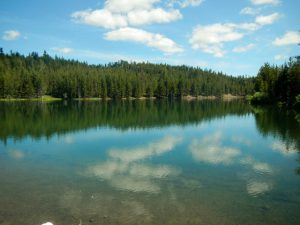
Snow Creek Pond (aka Teardrop Lake) is not far from Horseshoe Lake as the crow flies. To get there, take the Mesa Falls Scenic Highway to Three Rivers. Just below Warm River Campground, cross the river and travel up the Fish Creek Road about eight miles. Turn off right onto the Snow Creek Road, and proceed about three miles to this pond which is roadside left. Primitive camping sites are along the south shore where shallow water prevails for safe wading. Small boats and flotation devices can be launched here as well as at the north tip of the pond. Small brook trout have inhabited this pond as long as it has existed, and IDF&G replentishes its rainbow trout population. Both trout respond to small black leech patterns as well as drifting insect patterns.
This is but a sampler of the suitable locations in our area for entry-level fly-fishing, but those given above are among the most convenient. For sure there are others we can recommend. Visit the shop or contact us for more candidate waters to introduce that beginner to the fascinating fly-fishing world.
The Palisades Reservoir inflow seems to be equaling to the outflow. This could signal the light at end of the high flow tunnel. Keep watching our fishing report as we follow the flow out of Palisades Dam (currently about 19,000 cfs). Meanwhile, look for soft water along the river below for presenting nymph patterns deep from big rubber legs to your favorite bead heads.
Hebgen Lake offers perhaps the best still water fishing in our area. Gulpers are going on big time, and the Madison Arm offers a great location for enjoying them. We traveled past the south shore of Henry’s Lake yesterday and counted two boats in sight. That is good evidence that action there has slowed. Both Chesterfield and Twenty-Four Mile Reservoirs seem not to produce up to par, but Daniels Reservoir continues to be the best place for trout fishing in the southeast corner of Idaho. Midge pupa patterns at the taking depth and damselfly life cycle patterns are the standard fare for finding action. Springfield Reservoir is mossing up, so a good strategy is to fish channels between weed beds. Present dry damsel patterns to fish cruising these channels, and you will have action. Sand Creek Ponds open to non-motorized boat fishing after July 15th.
Here is a strategy constant for nearly the entire river; Our warm weather means that best fishing is in morning and late afternoon hours. This coincides with PM caddis activity and AM spinner falls. If you fish during mid day and see surface activity dwindling, switch to nymph patterns presented deep because waters are coolest there and thus hold higher dissolved oxygen concentrations. Flavs are still around as well as a few golden stones. Green drakes are pretty much gone for this year but some brown drakes with responses from trout can be seen during evenings. For sure, the current heat spell will help bring on terrestrial insects, so begin stocking up on ant, beetle, cranefly, and hopper patterns.
